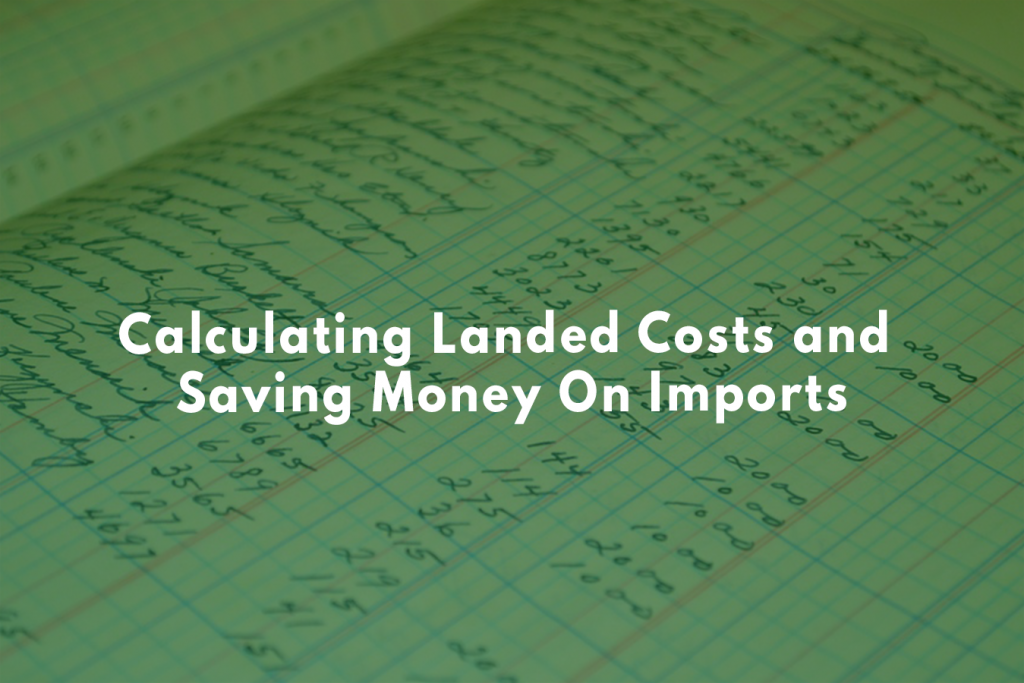If you’re in the business of importing and exporting, you’ve probably heard of landed costs. You’ve probably also heard that they’re vital to your shipping operations. But what is a landed cost? Why is it so important to do total landed cost analysis? We’ll define landed cost, help you with calculating landed costs, and give you a few other money saving tips for making sure your business is optimized.
What does landed cost mean?
The term landed cost refers to the total price placed on an item during its shipping journey. From the time it is shipped to the time it arrives at the final destination, any costs incurred will be counted in the landed cost of imports. This includes the price of goods, shipment costs, brokerage fees, insurance, tariffs, and customs duties.
Determining your landed cost is an important way to calculate your company’s bottom line. Whether you’re importing from a seller or exporting to buyer, it’s essential to have a representation of how much you can expect a shipping endeavor to cost.
Why you should be calculating landed costs
If you’re new to shipping, you’re bound to run into hidden costs. There are plenty of times you might not realize that you’ll have to reach into your pocket and pay. Experienced shippers may be better prepared to recognize where these little cash sinks are, but if you aren’t keeping track or preparing for them they could still amount to disruptive fees. Either way, the true cost of your products can seem unclear if you aren’t calculating landed costs. You should be doing this before you ship.
First and foremost, calculating landed costs will tell you whether you will be making a profit on your products. Without calculating, you risk finding out that your business model is not sustainable after you have already produced or even shipped an item. You do not want to discover that you won’t be making a profit after you’ve already committed to paying fees and duties.
Calculating landed costs will also enable you to take a good look at your supply chain and decide where it might be worth cutting costs. Analyzing what each step of the way looks like and how those steps affect your bottom line will give you control over your spending.
Knowing your landed costs will bring clarity and peace of mind. You’ll be able to evaluate how your business is performing, adjust your pricing to maximize profits and figure out exactly what it’s costing you or your company to produce, import, or export an item.
How to calculate landed costs
Calculating landed costs can be tricky. Often, you won’t get the true cost invoice until after you’ve shipped. If you don’t know what your expenses will be, this can be disconcerting. But if your business has the right processes in place, you shouldn’t have problems estimating numbers close to what the actual costs will be.
Fortunately, you’re not alone on this one. If you’re unsure about your internal processes for estimation, a customs broker can help you with this. Alternatively, you can also try it yourself with a free landed cost calculator online. Keep in mind that both of these methods will give you estimates only. A customs broker is the better choice if you want more nuanced estimates. Eventually, you should set up an internal method for reconciling your actual bills with your estimated prices. This way, you can keep track and make more accurate estimates in the future. Once you have either actual costs or estimates, you can use those to calculate landed costs.
The process of calculating landed costs involves using a mathematical formula. Let’s look at an example:
Let’s say you want to ship 100 units of an item from your factory to an end destination. The cost of each unit is $30. There is a duty of 4% on your items. The entire freight cost for the shipment you send was $1500. The item in question took up a quarter of the space in the shipping container.
Example of a Landed Cost Formula:
Information for 100 units received as part of a shipment:
- Supplier cost: $30 per unit
- Duty applicable at 4%
- Freight cost for the entire shipment was $1500
- Units took up 25% of the shipment
The landed cost formula for each unit would be:
$30 + (4% X $30) + (($1500 X 25%) / 100) = $34.95 per unit
This is a very simplified version of a landed cost formula. In reality, there would likely be many more factors to determine. These will change depending on where you’re shipping from, where you’re shipping to, how you’re shipping, and what you’re shipping etc. As a rule of thumb, find the costs of the following for your next shipment before attempting to calculate your total landed cost.
- Product cost
- Shipping: Costs associated with crating, packing, handling, and freight
- Customs: Duties, axes, tariffs, VAT, brokerage fees, harbor fees
- Risk: Insurance, compliance, quality, safety stock cost
- Overhead: Purchasing staff, due diligence cost, travel, exchange rates
A customs broker can help you with these, as well as determining any other costs. Once you’ve done this, you can review your supply chain and see where you can make changes to save money. You can also see exactly how much your profit will be, and adjust it based on the total landed cost. If an unexpected fee comes in, like a hold at customs costing you 100$ a day, you can incorporate that into your formula. Your new calculated landed cost will help you adjust the price you are selling or buying for in order to maximize profits.
Other Ways To Save Money On Imports
- Verify your HTS codes before shipping
If you are not double checking your Harmonized Tariff Schedule (HTS) codes, you may be misclassifying items and overpaying duties as a result. You should be evaluating each and every product you ship. It might seem simpler to classify similar items in the same way, but this could be costing you money. Check out our blog post on Customs Compliance to learn more about how classifying products diligently will help you in the long run.
- Know the country of origin of your products
Knowing the country that your products came from can let you participate in free trade agreements and duty preference programs. In some cases, you might be able to fully eliminate duties.
Within the U.S, there are not usually charges on duties for U.S made goods. You should be double checking to see if the items you’re importing are actually U.S returned goods. For example, U.S components assembled abroad and then re-imported are not dutiable. Clearer documentation and reporting could save you money.
- Negotiate Competitive Rates
Always be vigilant in understanding the market. Import managers should be on top of cost standards and ready to negotiate freight rates. Know what a competitive pricing is don’t be afraid to show that you do.
- Duty Drawbacks
Taking advantage of duty drawbacks allows you to get up to a 99% refund on duties and tariffs when you export goods that were imported to the United States. It sounds complicated so many shippers don’t bother. But did you know that $2.4 billion USD worth of refunds go unclaimed every year? Some of that might be your money! Learn more about duty drawbacks.
Once you’ve got these things down, you can start saving money in places you’ve never even considered before. Calculated landed costs are an important way to start, and these money saving tips will get you started in smarter shipping practices. For more tips and guidance, explore more of our Clearit blog. Whether you need help with calculating landed costs or saving money on your next shipment, Clearit has a team of trained brokers and specialists who are ready to help you. Get in touch today!






